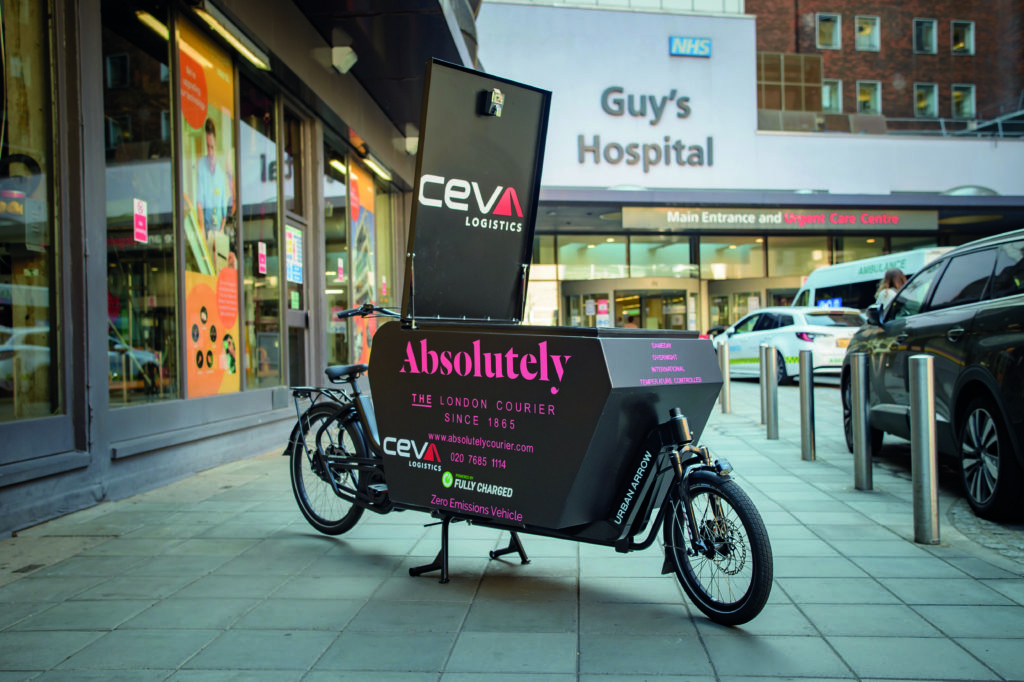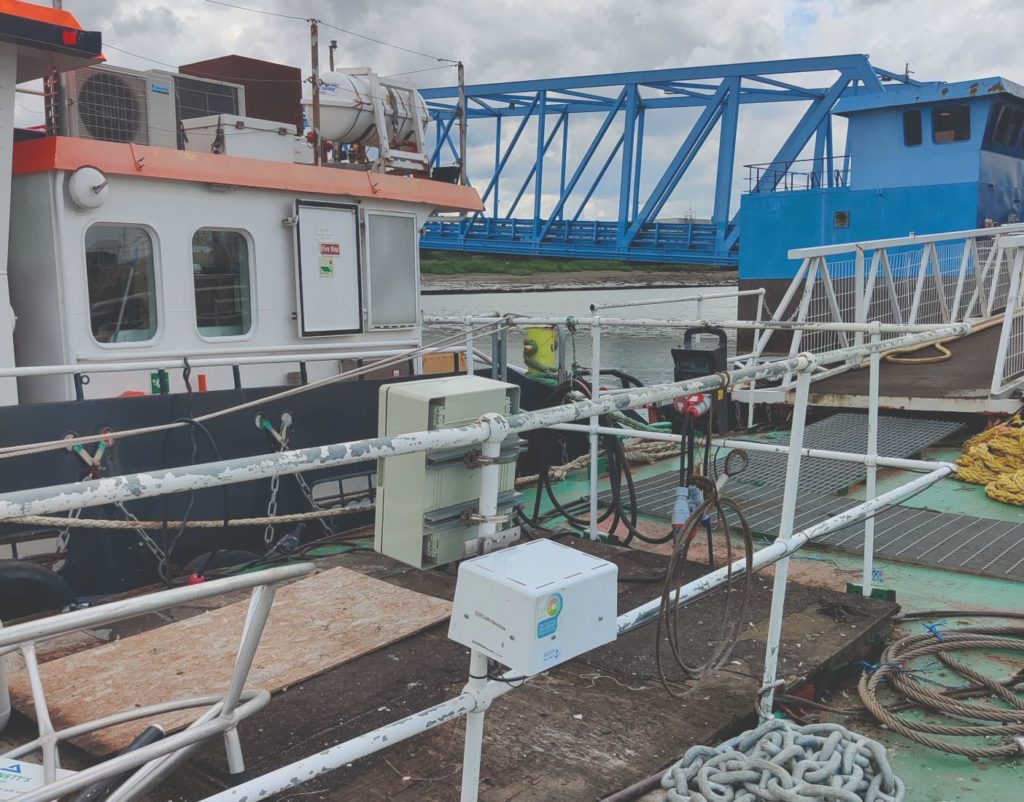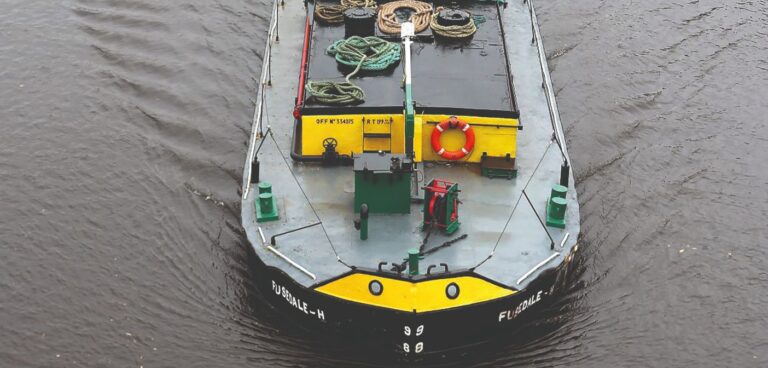David Smith on how the UK’s rivers are once again becoming a sustainable transport asset..
About 700,000 parcels a year are transported into London, a figure that will rise to about a billion by 2030, making the UK capital’s busy roads even more congested. The UK’s zero carbon target for 2050 has added more pressure to find greener solutions. Running through the heart of London, however, is the Thames river, which could become a “green superhighway” for light cargo. To date, DHL is one of few operators that has run light cargo services on the Thames. But for the past few months, Guy’s and St Thomas NHS Foundation Trust has been running a pilot scheme for medical supplies with impressive results.
“Our supply chains are fragile. We receive over 40,000 deliveries each year, but suffer shortages in inbound supply chains,” says David Lawson, the Trust’s head of procurement. “The Thames route is more expensive for now, but it gets supplies to the wards in the middle of the day in under an hour when lorries could take two hours.”
The pilot began on June 17 for three months but has been extended. Supplies are taken from the Trust’s consolidation supply-chain hub, which was established by CEVA Logistics in Dartford, half a mile down to the wharf. They are then carried by CEVA on a river boat service to Butler’s Wharf, near Tower Bridge. A business called Absolute Cargo takes the urgent medical devices to the hospitals on e-cargo bikes during the day. Meanwhile, in the evening, the boat handles bulkier items, such as boxes of syringes, gloves and PPE.
The scheme has enormous potential to save emissions if scaled up. The Trust’s three fossil-fuelled delivery trucks currently travel around 1,500 miles per week. For each truck removed from the road, about 708kg of CO2 could be saved per week. The river project was one measure outlined in the Trust’s 10-year sustainability plan, which set out a goal of reaching net zero carbon emissions by 2030.

Measured success
With the pilot proving a success, Lawson says the Trust now wants to encourage businesses in the investment districts around London Bridge to share the service, which is provided for CEVA by Livitt’s, a specialist in river logistics.
“We’ve had a few businesses on the boat and we expect to announce new partners before Christmas, which means we can share overheads and make it more sustainable,” he says. An important element of the pilot has been monitoring the air-quality levels of vessels carrying the cargo, as well as noise levels. Non-profit organisation Cross River Partnership (CRP) is working with air-quality specialist EMSOL to perform the monitoring. The study forms part of the Clean Air Villages 4 project, funded by the UK Department for Environment, Food and Rural Affairs. Monitoring devices have been placed on the boats, but also on the piers at both the London Bridge and Dartford sides.
“Precise emissions data allows us to compare it with the equivalent journey for a van,” says Kate Fenton, project manager for the CRP. “It’s vital to have proof of concept. We have ambitious goals to expand opportunities and so we need to be sure we’re promoting a superior environmental alternative.”
Measuring the noise monitoring is important, too, she says. No residents living near the piers want to be woken up by loud loading and unloading in the early hours. Meanwhile, devices on the boats help with noise attribution. “We’ll get detailed logs about where the boat’s going. If there’s a noise breach and we know the engine was switched off, we can attribute it to a different boat,” she says. “GPS data will also be matched to the air quality data and we’ll assess the dispersion of emissions into the air. Roadside emissions expose pedestrians and homeowners to exhaust fumes and tailpipe emissions, whereas on the river that’s not the case.”
Material gains
The NHS Trust and CEVA Logistics are working with a third partner, the Port of London Authority (PLA), on the project. The PLA is keen to help because the goals align with its Thames 2035 strategy, which aims to double intra-port freight. At the moment, the vast majority of the four million tonnes handled each year on the Thames is low-value, high-volume bulk materials. But the potential to handle time-sensitive light freight is high, according to James Trimmer, PLA’s director of planning and environment.
“Lots of parcels are distributed from within the Thames Gateway to consumers in central London. What connects origin and destination is the river. The river has roughly half the carbon of the road per kilometre, and less than rail, so we can compete on sustainability and reliability, but economics is paramount,” he says. “We’re working with 3PLs such as CEVA to get volumes up to drive costs down. Shared services will also lower unit costs.”
Last year, the PLA began working with DHL, which started a daily riverboat service, operated by Thames Clippers Logistics, at 7.30am. Shipments are loaded from electric vehicles onto the riverboat at Wandsworth Riverside Quarter Pier before travelling at high speed into central London, docking at Bankside Pier for final-mile delivery on bicycles. “The DHL project is unusual. Parcels come into Heathrow and are moved on the road to the river, where the final leg is from west to east. All our other pilots, and ones we’re planning, move cargo from east to west.”
To fully exploit the river, infrastructure changes will be required. The PLA has commissioned a pier adaptation study to determine how best to accommodate more light freight, including hand-held roll cages. At some piers, it might be necessary to “split the brow”, separating passengers from freight. A range of facilities, including e-cargo bikes, will help to connect the piers to the hinterland. “We’ve nowhere near full capacity compared with road and rail, but we need to get the infrastructure right. Even at the peak of summer, the Thames still has the space to accommodate a lot more cargo, and you can move a lot in one small passenger boat, up to three times what could be taken in a LGV,” he says.

Northern exposure
Outside London, the pressures to reduce carbon are also persuading organisations such as the Canal and River Trust (CRT), and local authorities, to think about how to increase cargo on waterways. The Canal and River Trust manages some 2,000 miles of waterways in England and Wales and has a legal obligation to facilitate freight on the bigger rivers and canals with direct links to the four major estuaries, the Humber, Mersey, the Thames and the Severn.
Stuart McKenzie, CRT’s freight operations planner, says there was a lot of freight activity on those waterways until about 2000, when it began to steadily decline. It was almost exclusively bulk cargo such as aggregates, liquids and oil. But there has been a renaissance of interest in recent years, he says. Like the PLA, Leeds City Council wants to encourage the transportation of more light cargo as part of the drive to be more sustainable and improve air quality. The council is putting in place a wharf protection strategy that reserves them for water usage and disallows the construction of houses and factories.
Meanwhile, the CRT has plans to build an inland port just outside Leeds. “If we put in hard-standing storage facilities, weybridges, a loading and discharge area, and cranes, we could even bring in containerised freight from ships in Hull. It might also require a few bridge alterations. But at that point, it’s possible to bring in white goods and electrics,” he says. “West Yorkshire Combined Authority has pledged half the money. But we’re still looking at other sources.”
Similarly, some major canals of the north of England have unused capacity. To just give one example, McKenzie says the Aire and Calder canal could carry between two- to five-million tonnes with ease each year if the infrastructure were improved, such as building two or three inland ports. “It used to do five- to seven-million tonnes when the coal stations were taking coal to power stations. There are a lot of ‘ifs’ needed to bring back the potential. If bridges were raised, if bends were straightened, if it were dredged deeper, if we trained crews. But it’s possible with the right investment,” he says.
Route canal
One of the European countries that exploits its city waterways for cargo transportation to the fullest potential is, of course, the Netherlands. Amsterdam alone has more than 90km of canals, which gave the city its nickname of ‘Venice of the North’. In the Dutch capital, the municipality provides electric boats called City Suppliers to transport light cargo. Meanwhile, DHL is also using boats on Amsterdam’s canals as floating distribution centres to transport cargo to points where e-bikes and electric vans can take them to their destinations.The Dutch city of Utrecht also has a maze of medieval canals. Its picturesque wharfs are now dotted with restaurants, craft shops and boutiques. But the waterways are still being used to deliver goods to about 70 companies located near the canals. As in Amsterdam, the city authorities have been proactive. They hire out special pollution-free electric boats to do the deliveries.
Setting the Seine
City authorities in Paris, like London, are thinking about how to exploit the potential of the Seine for light cargo. One of the most innovative projects involves the deployment of the world’s first commercial cargo hydrogen vessel. The 164ft-long vessel will move pallets and containers on the river and is expected to be in operation by the end of this year.
The boat will operate its fuel-cell batteries on compressed hydrogen produced from electrolysis, enabling zero-emission operations. The boat is part of the EU’s Flagships project, a consortium of 12 European partners from the shipping industry. It is owned by French inland shipowner Compagnie Fluvial de Transport, a subsidiary of Sogestran Group. The Flagships project, which has installed a hydrogen power generation system near the Seine, was awarded €5m (£4.2m) in 2018 from the EU’s Research and Innovation programme Horizon 2020, under the Fuel Cells and Hydrogen Joint Undertaking, to deploy two hydrogen vessels in France and Norway. The project’s initial plan was to deploy a hydrogen push-boat in the Lyon area, but as the broader potential for hydrogen in cargo transport emerged, the demo pusher was changed to an inland cargo vessel for the Seine.
This article was originally published in the November 2021 issue of CiTTi. Click here to view the original article.





